Use These Non-Permissive Environment Carry Tips to Enhance Your Concealed Carry
Use These Non-Permissive Environment Carry Tips to Enhance Your Concealed Carry
Civilians who go through their day armed face an interesting paradox. Though we as a class of gun-carriers certainly have the most total man-hours spent carrying concealed and potentially the highest stakes if discovered, some of us seemingly don’t care about employing the best practices to accomplish our objective. That objective is simply to get through our daily itinerary with no fuss and no hassle, unassailed and ideally to carry our pistols undiscovered, with no one the wiser.
The consequences of being detected or “made” as a concealed carrier can range from none to a mild fracas and embarrassment, to being relieved of “your” pistol by force and summarily killed with it by an attacker. That’s quite the variety. Regrettably, a combination of persistent folklore, obliviousness and old-fashioned laziness lead to a depressingly large number of civilians making serious mistakes when concealing a pistol. Worse, a few detestable critters strap on their handgun with little or no mandate to properly conceal or protect the gun beyond “cover it up.” (If even that.) This is usually before heading out blithely into an overwhelmingly forgiving and permissive social environment (pistol dangling from a crappy nylon holster) to plunder chips, dip and beer from the grocery and hit up the Redbox on the way out. This is woefully deficient, procedurally and ethically.
We’re fortunate to live in a country so incredibly safe that even serious lapses in procedure or attention rarely result in grievous consequences. However, that’s obviously not a constant. Bad things are regularly done to good people and when they are, it isn’t merely bad luck. The outcome is influenced by one’s own omission of action or mistakes. The truth is your pistol being visible, even detectable, is enough to influence a situation negatively or even see you chosen as a victim.
Conceal Like Your Life Depends On It. It Might.
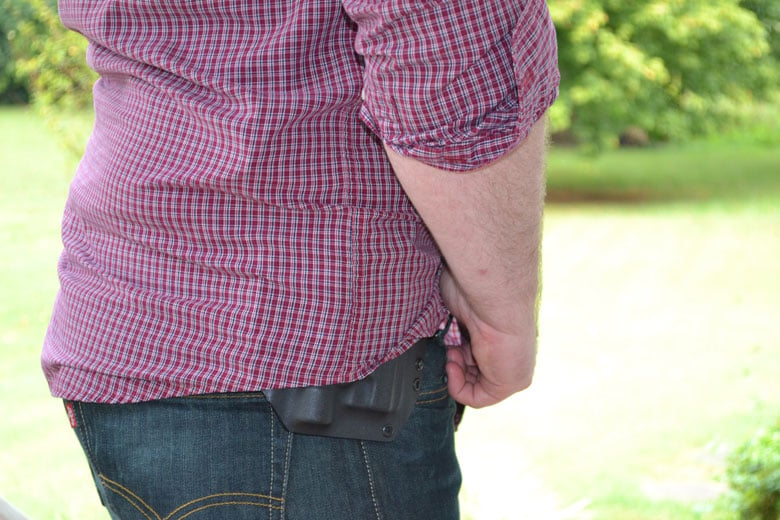
I’m terribly serious about the ramifications of civilians carrying guns into public places. Any good person armed with a gun has a moral responsibility to be as proficient as they can with it; for their sake and the sake of those around them. Despite the gravity that carrying a gun potentially brings to all interactions with strangers, most shooters aren’t working their concealment skills and theory as hard as they work their pistol skills. This is a big mistake because it could be your concealment skills, or lack thereof, that get you into trouble in the first place.
In the interest of rectifying some of the worst mistakes and lapses in judgment I see committed when carrying concealed, I’ve interviewed my friend and mentor Justin Ward. He’s a former Marine and expert personal security specialist with boat-loads of experience carrying handguns concealed in places where the consequences of discovery are far more drastic than getting you run out of Pottery Barn again.
Justin is a supremely skilled shooter with a great depth of experience carrying concealed at home and abroad. Most importantly, he’s a hardcore student of guncraft and has done a more serious study on the use and carry of pistols than anyone I know personally. He’s going to be hanging up his shingle in the training sector soon, so keep an eye out for his wisdom in your travels.
He and I recently had a long conversation about the topic of concealment. His experiences carrying pistols in high-risk environments have greatly influenced his techniques and procedures when carrying at home. It turned into a pretty illuminating discussion for me. So much so, that I decided to interview him and present his answers and the lessons learned here on ITS.
Learn what you can from his experience, but more importantly use this information to review your concealment techniques and procedures with an eye toward best practices.
Risks of Detection
Chad: What risks would you face if you were detected carrying concealed?
Justin: Northern Iraq/Iraqi Kurdistan is unique in the Middle East, with the exception of Israel. Kurdistan is very pro-American. I was legally allowed to carry there, but if not, it’s still unlikely that I would face legal consequences if discovered. During the height of the recent ISIS conflict, Americans were welcomed, even in areas where Iraqi Arabs were prohibited from visiting.
The issue is this can give a false sense of confidence. Often, it’s not what you’re doing, but how you present yourself that decides how much scrutiny you receive. In areas controlled by the Iraqi Central government, even though it was unlikely that I would be searched, I would still not risk carrying a weapon without a license. Turkey is a no-go for an armed American. You will be stopped and you will be searched.
Lesson: Know the legal ramifications of carrying in your locale, even in pro-gun places. Don’t assume that because you’re in a politically welcoming area, misbehavior or transgression won’t result in consequences.
Carry Positions
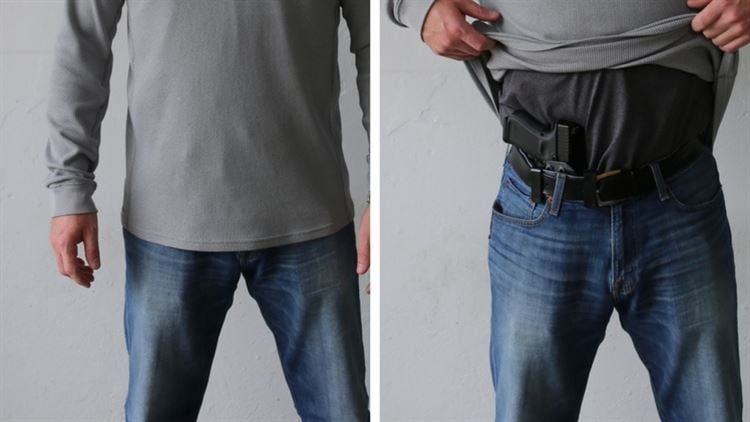
Chad: What carry positions or methods did you find yourself relying on?
Justin: Typically behind the hip, about 4 o’clock was by far the most common carry. All of our holsters were designed for that purpose. The reason is that in a vehicle, low profile, with body armor, it makes the most sense. Not knocking appendix carry, but in those situations, behind the hip worked best for us.
Lesson: Context is everything when selecting a mode of carrying a weapon, etc. Appendix carry and strongside carry have many advantages, arguably more than behind-the-hip carry, but your preference may give way to necessity when the situation changes or you’re dressed up in a sensitive environment. Likewise, with guns, your Roland Special may get left behind for a J-frame or LCP in a pocket holster, depending on the situation.
While “it works for me” is the ideological equivalent of a belly flop, don’t become so inured with what’s best on paper that you lose sight of your objective. Pick the right tool and always remember that your mission drives the gear train.
Grey Man Status
Chad: How do you achieve a truly low-profile or, as much as I loathe the term, “Grey Man” status in such environments?
Justin: I’m a 6’2″ bald white guy. For instance, the average Kurdish male is probably around 5’6″, has hair on his head and is brown skinned. Before deploying, I studied pictures of what the most common dress in the area was and tried to replicate that in a way that didn’t look like an outsider simply trying to copy them. Dark jeans and a solid color button down shirt seemed to be the way to go. Although for some missions, when they see an American they expect him to dress the part. So I did have a couple of pairs of 5.11 tactical pants in my closet for those trips.
One tip I’ll give the average concealed carrier is stop buying tactical grey man stuff. Buy civilian attire that fulfills your tactical needs. Vehicle choice is huge for me, too. I don’t want something that sticks out; too nice or too crappy. I like a four-wheel drive vehicle, commonly used in the area, a few years old.
Lesson: In some places, even neighborhoods, you won’t be able to truly blend in. Maybe it’s your accent, skin color or something else like your attire or vehicle. Maybe you’re just a huge person and draw looks. To avoid garnering undue attention, pay attention to what the local “dress code” is and try to adhere to it more or less.
Camouflage isn’t a pattern or color. Dressing in straight coyote tan or manatee gray from head to toe looks so drab and unusual to most, you’ll get the opposite of your desired response. Camouflage is blending in. If I was really serious about blending in at a ballgame, for instance, I’d probably wear a jersey or other fan apparel; though I’d never wear one otherwise. If your job or professional environment dictates a certain uniform or standard of dress, conceal what you can within the constraints of that attire.
Avoiding Detection
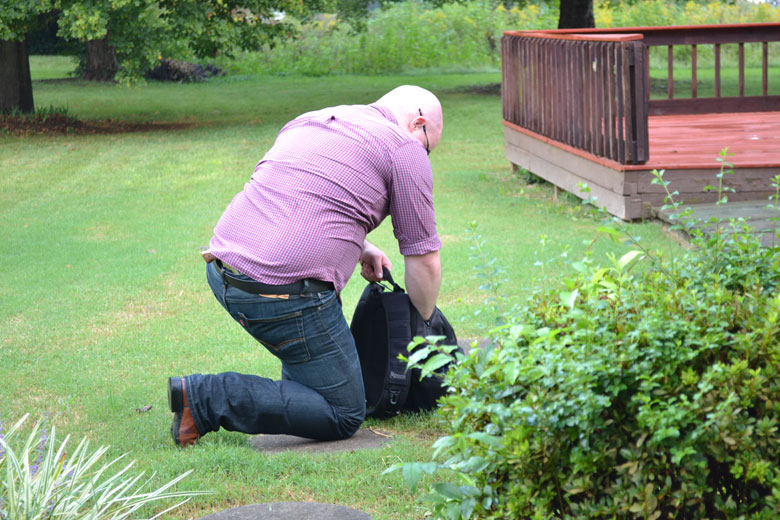
Chad: Were you only concerned with the gun being detected or yourself being made as a gun carrier?
Justin: Both, but I definitely don’t want my bearing to get me pinged as someone worth messing with for any reason. My rule is to be dangerous, but don’t look dangerous. I’m very careful with the way I carry and project myself so I don’t invite trouble from would-be tough guys or someone looking to make an example. My comportment is upright, fluid and aware. Not challenging, not aggressive and definitely not swaggering, cause I have a pistol. I hate the hard-guy act because it invites trouble.
Lesson: Even with perfect concealment, your attitude, attire and other factors may see adversaries make you as a gun-carrier. This isn’t ideal. A very safe environment and pure good luck will lead many civilian carriers to believe they’ve never been made when the opposite is true. If someone doesn’t tip their hand that they know you’re armed, how are you supposed to know?
Similarly, don’t overdo a confident, assured Condition Yellow into Condition Basket-case. A visibly tense, “switched-on” or hyped-up person is easily noticed and attracts the wrong kind of attention from your fellow citizens. Relax. Look people in the eye long enough so they know you see them, but no longer. Locked eye-contact is a challenge in virtually every place and culture.
Concealed vs. Open
Chad: If you had a choice to carry concealed or openly, did you prefer one over the other? What advantages did your choice confer?
Justin: In a civilian environment, always concealed. Always. If the situation means it would be appropriate to walk around with a long gun, then by all means, open carry whatever you want. If someone knows you are carrying, it is prematurely introduced into every encounter and every interaction you have going forward. That’s not a good thing out in the world. The known presence of a gun often creates more problems than it solves. Keep it concealed.
Lesson: Openly carrying is a bad play in public places. Same goes for a sloppily concealed pistol; you aren’t fooling anyone as to what’s under your schmedium-sized shirt. Once someone knows you have it, there’s no undoing it. Bad guys may use that information against you. Remember the worst among them aren’t afraid of your gun, or will simply wait for an opportune time to bushwhack you.
An openly carried gun is no deterrent to criminality. If it was, we wouldn’t have so many cops being attacked lately. If it doesn’t work for them as a deterrent against harm, it sure won’t work for you. Understand you may make yourself a target because the gun is visible! The Law of the Jungle makes clear that the gun on your hip does not belong to you, it belongs to whoever wants it the most.
As far as your innocent fellow citizens are concerned, your right to open carry still exists alongside manners and ethics. Don’t scare the horses. Don’t make people nervous without cause. You’re a stranger to the rest of the populace. They likely don’t share your value system and way of life. Consider that.
Let me say it as plainly as possible, compared to concealed carry, open carry is inferior for civilians in virtually every situation. Take pains to keep your pistol as concealed as possible.
Conclusion
While most of us won’t be put in such hairy situations as Justin and others in his line of work, the lessons learned from concealed carry in high-risk locales are no less valid here at home. While the chances of it occurring are smaller, the stakes (should an attack occur) are just as high. Step up your concealment game and remain just another face in the crowd.
Editor-in-Chief’s Note: Chad Nabors writes about firearms, with a strong focus on concealed carry, pistols and daily preparedness. His background is in commercial sales, training and armor development and testing. He’s trained many citizens on the pistol from basic to advanced skills and resides somewhere in Greater Appalachia, where he still rocks a classic double-action SIG. He hates low-quality guns and never wears camo. You can reach him at [email protected]
Photography by Ben Stephens of One Seven Photography.






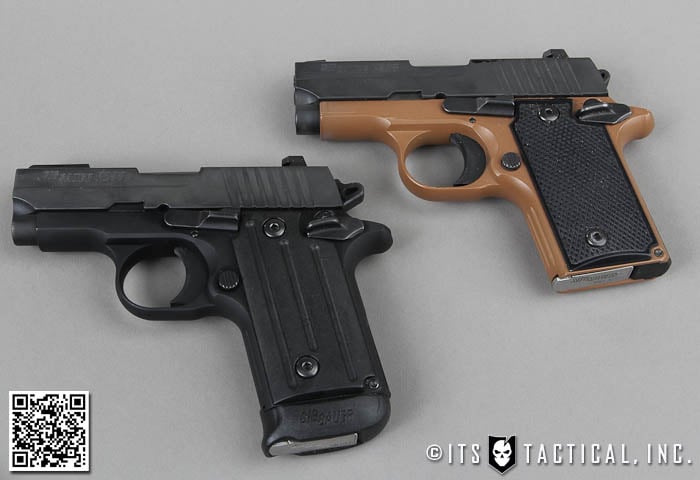
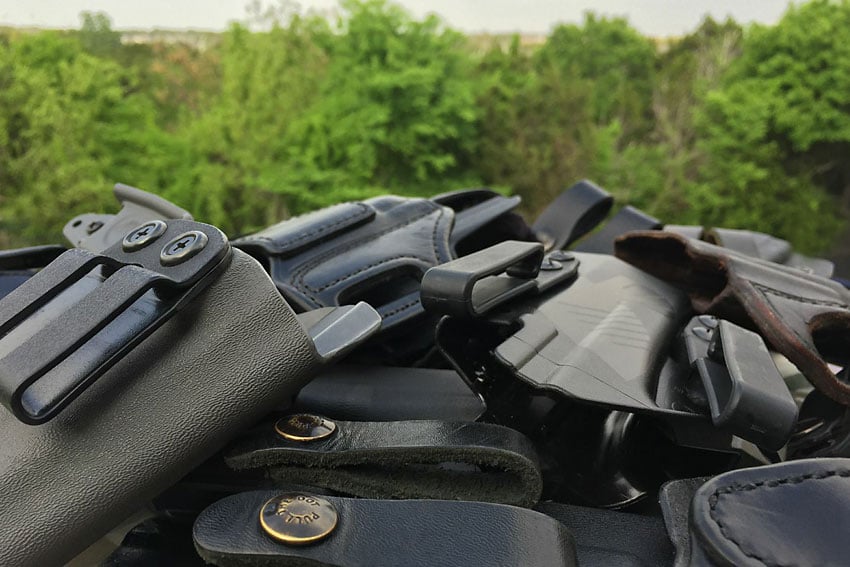
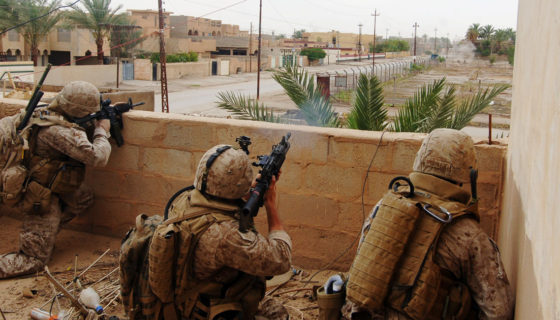
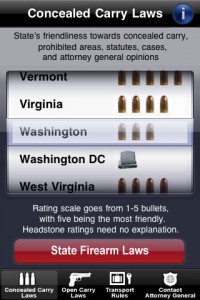

Discussion